Effect of Alkaline Artificial Seawater Environment on the Corrosion Behaviour of Duplex Stainless Steel 2205
Abstract
Featured Application
Abstract
1. Introduction
2. Materials and Methods
2.1. Materials
2.2. Medium and Test Conditions
2.3. Analytical Methods
2.4. Biofilm Formation
2.5. Electrochemical Testing
2.6. EIS (Electrochemical Impedance Spectroscopy)
2.7. Sulphide Level and pH Level
2.8. Inductively Coupled Plasma Mass Spectrometry (ICPMS) Analysis
2.9. Surface Analysis
3. Results
3.1. Sulphide Concentration and pH Variation
3.2. Biofilm Formation
3.3. Electrochemical Testing
3.4. Metal Concentrations
3.5. SEM Images of COUPONS immersed in Different pH Environments
4. Discussion
4.1. Effect of Environment pH on Bacteria Growth and Bacteria Attachment
4.2. Effect of pH on Microbial Corrosion Behaviour
- For the first 2 h of exposure, the increase in biofilm thickness was too low to act as a barrier to prevent diffusion of metal ions to the environment. Therefore, the impedance of materials depended on their passive film. It has been shown in previous literature that passive film has semiconducting properties [60,61,62]. The films are characterised by the presence of electrical barriers developed at the film–electrolyte interface and at the junction [61]. The donors or acceptors in semiconducting passive layers are defects, including cationic and anionic vacancies or cationic interstitials. These vacancies act as the dopants. For instance, cation interstitials imparting n-type character and cation vacancies yielding p-type character of semiconducting properties of passive film. Thus, the presence of these dopants prevent the diffusion of ion from metal substrate and the penetration of damaging anion such as Cl− from electrolyte [61,62]. As the pH of the environment increases, the density of dopants increases, thereby increasing the corrosion resistance [10], represented by higher radius impedance of working electrode in pH 10 solution than others (Figure 6a).
- There was a gradually enrichment of chromium content on the passive film layer as pH increased. Thus, the space charge layer increases with the chromium content [10] which results in higher pitting resistance.
4.3. Corrosion Mechanism
5. Conclusions
- Desulfovibrio vulgaris was active in alkaline environments at pH 7–9. At pH 10, there was an initial lag phase of around 8 days.
- The pH of the bulk environment decreased to pH 7.5 during exposure time due to the production of corrosion products.
- For the first two days of exposure, the corrosion resistance of the materials depended mostly on their passive film. Higher pH environments could support higher corrosion resistance of materials.
- After 28 days exposure to SRB environment, the pH of the environment shifted to pH 7.5 and corrosion still occurred. Thus, strategies to increase the pH to control MIC is unlikely to be successful.
- The corrosion rate of DSS 2205 at pH 9 was higher than other pH environment as it has the highest current density (0.867 mA·cm−2) due to higher dissolution of hydrogen sulphide.
- A mechanism of the change in environmental pH and the corrosion of duplex stainless steels in the presence of SRB in alkaline environment is proposed.
Author Contributions
Funding
Acknowledgments
Conflicts of Interest
References
- Javaherdashti, R. A brief review of general patterns of MIC of carbon steel and biodegradation of concrete. IUFS J. Biol. 2009, 68, 65–73. [Google Scholar]
- Coetser, S.; Cloete, T.E. Biofouling and biocorrosion in industrial water systems. Crit. Rev. Microbiol. 2005, 31, 213–232. [Google Scholar] [CrossRef] [PubMed]
- Gu, T. New understandings of biocorrosion mechanisms and their classifications. J. Microbial. Biochem. Technol. 2012, 4, 4. [Google Scholar] [CrossRef]
- Little, B.; Blackwood, D.; Hinks, J.; Lauro, F.; Marsili, E.; Okamoto, A.; Rice, S.; Wade, S.; Flemming, H. Microbially influenced corrosion–any progress? Corros. Sci. 2020, 170, 108641. [Google Scholar] [CrossRef]
- Zhang, C.; Wen, F.; Cao, Y. Progress in research of corrosion and protection by sulfate-reducing bacteria. Procedia Environ. Sci. 2011, 10, 1177–1182. [Google Scholar] [CrossRef]
- Enning, D.; Garrelfs, J. Corrosion of Iron by Sulfate-Reducing Bacteria: New Views of an Old Problem. Appl. Environ. Microbiol. 2014, 80, 1226–1236. [Google Scholar] [CrossRef]
- Schaschl, E. Elemental sulfur as a corrodent in deaerated neutral aqueous solutions. Brea Mater. Perform. 1980, 19, 4. [Google Scholar]
- Newman, R.; Wong, W.; Garner, A. A mechanism of microbial pitting in stainless steel. Corrosion 1986, 42, 489–491. [Google Scholar] [CrossRef]
- Chen, G.; Clayton, C. Influence of sulfate-reducing bacteria on the passivity of type 304 austenitic stainless steel. J. Electrochem. 1997, 144, 3140–3146. [Google Scholar] [CrossRef]
- Luo, H.; Dong, C.; Li, X.; Xiao, K. The electrochemical behaviour of 2205 duplex stainless steel in alkaline solutions with different pH in the presence of chloride. Electrochim. Acta 2012, 64, 211–220. [Google Scholar] [CrossRef]
- Rajala, P.; Bomberg, M.; Vepsäläinen, M.; Carpén, L. Microbial fouling and corrosion of carbon steel in deep anoxic alkaline groundwater. Biofouling 2017, 33, 195–209. [Google Scholar] [CrossRef] [PubMed]
- Bakar, A.A.; Noor, N.M.; Yahaya, N.; Rasol, R.M.; Fahmy, M.K.; Fariza, S.N.; Rashid, A.S.A. Disinfection of Sulphate Reducing Bacteria using Ultraviolet Treatment to Mitigate Microbial Induced Corrosion. J. Biol. Sci. 2014, 14, 349–354. [Google Scholar]
- Buchanan, R.A.; Li, P.; Zhang, X.; Dowling, N.; Stansbury, E.; Danko, J.; White, D. Electrochemical Studies of Microbiologically Influenced Corrosion; Electric Power Research Institute: Palo Alto, CA, USA, 1991. [Google Scholar]
- Chardin, B.; Giudici-Orticoni, M.-T.; De Luca, G.; Guigliarelli, B.; Bruschi, M. Hydrogenases in sulfate-reducing bacteria function as chromium reductase. Appl. Microbiol. Biotechnol. 2003, 63, 315–321. [Google Scholar] [CrossRef] [PubMed]
- Dec, W.; Jaworska-Kik, M.; Simka, W.; Michalska, J.J.M. Corrosion behaviour of 2205 duplex stainless steel in pure cultures of sulphate reducing bacteria: SEM studies, electrochemical characterisation and biochemical analyses. Mater. Corros. 2018, 69, 53–62. [Google Scholar] [CrossRef]
- Fang, H.H.; Xu, L.-C.; Chan, K.-Y. Influence of Cr3+ on microbial cluster formation in biofilm and on steel corrosion. Biotechnol. Lett. 2000, 22, 801–805. [Google Scholar] [CrossRef]
- Huttunen-Saarivirta, E.; Honkanen, M.; Lepistö, T.; Kuokkala, V.-T.; Koivisto, L.; Berg, C.-G. Microbiologically influenced corrosion (MIC) in stainless steel heat exchanger. Appl. Surf. Sci. 2012, 258, 6512–6526. [Google Scholar] [CrossRef]
- Li, H.; Zhou, E.; Zhang, D.; Xu, D.; Xia, J.; Yang, C.; Feng, H.; Jiang, Z.; Li, X.; Gu, T. Microbiologically influenced corrosion of 2707 hyper-duplex stainless steel by marine Pseudomonas aeruginosa biofilm. Sci. Rep. 2016, 6, 20190. [Google Scholar] [CrossRef]
- Mansouri, H.; Alavi, S.A.; Javaherdashti, R.; Esmaeili, H.; Mansouri, H.; Kariman, A. pH effect microbial corrosion of Corten steel and Carbon steel in oily waste water with Pseudomonas Aeruginosa. IOSR J. Eng. 2014, 4, 28–32. [Google Scholar] [CrossRef]
- Lou, Y.; Dai, C.; Chang, W.; Qian, H.; Huang, L.; Du, C.; Zhang, D. Microbiologically influenced corrosion of FeCoCrNiMo0. 1 high-entropy alloys by marine Pseudomonas aeruginosa. Corros. Sci. 2019, 165, 108390. [Google Scholar] [CrossRef]
- Ziadi, I.; Alves, M.; Taryba, M.; El-Bassi, L.; Hassairi, H.; Bousselmi, L.; Montemor, M.; Akrout, H. Microbiologically influenced corrosion mechanism of 304L stainless steel in treated urban wastewater and protective effect of silane-TiO2 coating. Bioelectrochemistry 2020, 132, 107413. [Google Scholar] [CrossRef]
- Unsal, T.; Ilhan-Sungur, E.; Arkan, S.; Cansever, N. Effects of Ag and Cu ions on the microbial corrosion of 316L stainless steel in the presence of Desulfovibrio sp. Bioelectrochemistry 2016, 110, 91–99. [Google Scholar] [CrossRef] [PubMed]
- Javaherdashti, R. Microbiologically influenced corrosion. In An Engineering Insight; Springer: London, UK, 2008; pp. 29–71. [Google Scholar]
- Betova, I.; Bojinov, M.; Hyökyvirta, O.; Saario, T. Effect of sulphide on the corrosion behaviour of AISI 316L stainless steel and its constituent elements in simulated Kraft digester conditions. Corros. Sci. 2010, 52, 1499–1507. [Google Scholar] [CrossRef]
- Wiener, M.S.; Salas, B.; Quintero-Nunez, M.; Zlatev, R. Effect of H2S on corrosion in polluted waters: A review. Corros. Eng. Sci. Technol. 2006, 41, 221–227. [Google Scholar] [CrossRef]
- Davoodi, A.; Pakshir, M.; Babaiee, M.; Ebrahimi, G.R. A comparative H2S corrosion study of 304L and 316L stainless steels in acidic media. Corros. Sci. 2011, 53, 399–408. [Google Scholar] [CrossRef]
- Starosvetsky, D.; Starosvetsky, J.; Armon, R.; Ein-Eli, Y. A peculiar cathodic process during iron and steel corrosion in sulfate reducing bacteria (SRB) media. Corros. Sci. 2010, 52, 1536–1540. [Google Scholar] [CrossRef]
- Park, J.O.; Böhni, H. Local pH measurements during pitting corrosion at MnS inclusions on stainless steel. Electrochem. Solid. State Lett. 2000, 3, 416–417. [Google Scholar] [CrossRef]
- Williams, D.E.; Kilburn, M.R.; Cliff, J.; Waterhouse, G. Composition changes around sulphide inclusions in stainless steels, and implications for the initiation of pitting corrosion. Corros. Sci. 2010, 52, 3702–3716. [Google Scholar] [CrossRef]
- Venzlaff, H.; Enning, D.; Srinivasan, J.; Mayrhofer, K.J.; Hassel, A.W.; Widdel, F.; Stratmann, M. Accelerated cathodic reaction in microbial corrosion of iron due to direct electron uptake by sulfate-reducing bacteria. Corros. Sci. 2013, 66, 88–96. [Google Scholar] [CrossRef]
- Cao, J.; Zhang, G.; Mao, Z.; Fang, Z.; Yang, C. Precipitation of valuable metals from bioleaching solution by biogenic sulfides. Miner. Eng. 2009, 22, 289–295. [Google Scholar] [CrossRef]
- Ismail, M.; Noor, N.M.; Yahaya, N.; Abdullah, A.; Rasol, R.M.; Rashid, A.S.A. Effect of pH and temperature on corrosion of steel subject to sulphate-reducing bacteria. Environ. Sci. Technol. 2014, 7, 209–217. [Google Scholar]
- Sheng, X.; Ting, Y.-P.; Pehkonen, S.O. The influence of sulphate-reducing bacteria biofilm on the corrosion of stainless steel AISI 316. Corros. Sci. 2007, 49, 2159–2176. [Google Scholar] [CrossRef]
- Marchal, R.; Chaussepied, B.; Warzywoda, M. Effect of ferrous ion availability on growth of a corroding sulfate-reducing bacterium. Int. Biodeterior. Biodegrad. 2001, 47, 125–131. [Google Scholar] [CrossRef]
- King, F. Corrosion resistance of austenitic and duplex stainless steels in environments related to UK geological disposal. In Nuclear Decommissioning Authority, UK; Quintessa Ltd.: Henley-on-Thames, UK, 2009. [Google Scholar]
- Widdel, F. Microbiology and ecology of sulfate-and sulfur-reducing bacteria. In Biology of Anaerobic Microorganisms, 99th ed.; Zehnder, A.J.B., Ed.; Wiley-Interscience Press: Oakland, CA, USA, 1988; pp. 469–585. [Google Scholar]
- Postgate, J. The Sulfate-Reducing Bacteria; Cambridge University Press: Cambridge, UK, 1984; p. 239. [Google Scholar]
- Barton, L.L.; Tomei, F.A. Characteristics and activities of sulfate-reducing bacteria. In Sulfate-Reducing Bacteria; Springer: Berlin/Heidelberg, Germany, 1995; pp. 1–32. [Google Scholar]
- Zhilina, T.N.; Zavarzin, G.A. Alkaliphilic anaerobic community at pH 10. Curr. Microbiol. 1994, 29, 109–112. [Google Scholar] [CrossRef]
- Ryzhmanova, Y.; Nepomnyashchaya, Y.; Abashina, T.; Ariskina, E.; Troshina, O.; Vainshtein, M.; Shcherbakova, V. New sulfate-reducing bacteria isolated from Buryatian alkaline brackish lakes: Description of Desulfonatronum buryatense sp. nov. Extremophiles 2013, 17, 851–859. [Google Scholar] [CrossRef] [PubMed]
- Bomberg, M.; Arnold, M.; Kinnunen, P. Characterization of the bacterial and sulphate reducing community in the alkaline and constantly cold water of the closed Kotalahti Mine. Minerals 2015, 5, 452–472. [Google Scholar] [CrossRef]
- Goeres, D.; Nielsen, P.H.; Smidt, H.; Frølund, B. The effect of alkaline pH conditions on a sulphate reducing consortium from a Danish district heating plant. Biofouling 1998, 12, 273–286. [Google Scholar] [CrossRef]
- ASTM International. D1141-98: Standard Practice for the Preparation of Substitute Ocean Water; ASTM International: West Conshohocken, PA, USA, 2013. [Google Scholar]
- Mansfeld, F.; Little, B. A technical review of electrochemical techniques applied to microbiologically influenced corrosion. Corros. Sci. 1991, 32, 247–272. [Google Scholar] [CrossRef]
- ASTM G1-03. In Standard Practice for Preparing, Cleaning, and Evaluating Corrosion Test Specimens, Annual Book of ASTM Standards; ASTM International: Conshohocken, PA, USA, 2003; Volume 3, pp. 17–25.
- Liu, Y.; Li, H.; Li, Z. EIS investigation and structural characterization of different hot-dipped zinc-based coatings in 3.5% NaCl solution. Int. J. Electrochem. Sci. 2013, 8, 7753–7767. [Google Scholar]
- Bard, A.J.; Faulkner, L.R.; Leddy, J.; Zoski, C.G. Electrochemical Methods: Fundamentals and Applications; Wiley: New York, NY, USA, 1980; Volume 2. [Google Scholar]
- Kim, T.; Kang, J.; Lee, J.-H.; Yoon, J. Influence of attached bacteria and biofilm on double-layer capacitance during biofilm monitoring by electrochemical impedance spectroscopy. Water Res. 2011, 45, 4615–4622. [Google Scholar] [CrossRef]
- Prithiraj, A.; Otunniyi, I.O.; Osifo, P.; van Der Merwe, J. Corrosion behaviour of stainless and carbon steels exposed to sulphate–reducing bacteria from industrial heat exchangers. Eng. Fail. Anal. 2019, 104, 977–986. [Google Scholar] [CrossRef]
- Revsbech, N.P.; Jørgensen, B.B. Microelectrodes: Their use in microbial ecology. In Advances in Microbial Ecology; Springer: Berlin/Heidelberg, Germany, 1986; pp. 293–352. [Google Scholar]
- Lee, W.; de Beer, D. Oxygen and pH microprofiles above corroding mild steel covered with a biofilm. Biofouling 1995, 8, 273–280. [Google Scholar] [CrossRef]
- Stolyar, S.; He, Q.; Joachimiak, M.P.; He, Z.; Yang, Z.K.; Borglin, S.E.; Joyner, D.C.; Huang, K.; Alm, E.; Hazen, T.C. Response of Desulfovibrio vulgaris to alkaline stress. J. Bacteriol. Res. 2007, 189, 8944–8952. [Google Scholar] [CrossRef]
- Bertrand, J.-C.; Caumette, P.; Lebaron, P.; Matheron, R.; Normand, P.; Sime-Ngando, T. Environmental Microbiology: Fundamentals and Applications; Springer Science & Business Media: Dordrecht, The Netherlands, 2015. [Google Scholar]
- Dworkin, M. The Prokaryotes: Bacteria: Firmicutes, Cyanobacteria; Springer Science & Business Media: New York, NY, USA, 2006; Volume 4. [Google Scholar]
- Renault, P.; Stengel, P. Modeling oxygen diffusion in aggregated soils: I. Anaerobiosis inside the aggregates. Soil Sci. Soc. Am. J. 1994, 58, 1017–1023. [Google Scholar] [CrossRef]
- Dilworth, M.; Glenn, A. Problems of Adverse pH and Bacterial Strategies to Combat It; Wiley: Chichester, UK, 1999. [Google Scholar]
- Padan, E.; Bibi, E.; Ito, M.; Krulwich, T.A. Alkaline pH homeostasis in bacteria: New insights. Biochim. Biophys. Acta Biomembr. 2005, 1717, 67–88. [Google Scholar] [CrossRef] [PubMed]
- Skulachev, V.P.; Kobayashi, H.; Krulwich, T.; Schafer, G.; Fillingame, R.; Poole, R.; Cook, G.; Dimroth, M.; Konings, W.; Stock, J. Bacterial energetics at high pH: What happens to the H^+ cycle when the extracellular H^+ concentration decreases? In Novartis Foundation Symposium; Wiley: Hoboken, NJ, USA, 1999; pp. 200–217. [Google Scholar]
- Center for Environmental Research Information. Odor and Corrosion Control in Sanitary Sewerage Systems and Treatment Plants: Design Manual; Center for Environmental Research Information, US Environmental Protection Agency, Office of Research and Development: Washington, DC, USA, 1985.
- Di Paola, A. Semiconducting properties of passive films on stainless steels. Electrochim. Acta 1989, 34, 203–210. [Google Scholar] [CrossRef]
- Carmezim, M.; Simões, A.; Figueiredo, M.; Belo, M.D.C. Electrochemical behaviour of thermally treated Cr-oxide films deposited on stainless steel. Corros. Sci. 2002, 44, 451–465. [Google Scholar] [CrossRef]
- Goodlet, G.; Faty, S.; Cardoso, S.; Freitas, P.; Simoes, A.; Ferreira, M.; Belo, M.D.C. The electronic properties of sputtered chromium and iron oxide films. Corros. Sci. 2004, 46, 1479–1499. [Google Scholar] [CrossRef]
- Edyvean, R. Hydrogen sulphide—A corrosive metabolite. Int. Biodeterior. 1991, 27, 109–120. [Google Scholar] [CrossRef]
- Santos, A.A.; Venceslau, S.S.; Grein, F.; Leavitt, W.D.; Dahl, C.; Johnston, D.T.; Pereira, I.A. A protein trisulfide couples dissimilatory sulfate reduction to energy conservation. Science 2015, 350, 1541–1545. [Google Scholar] [CrossRef]
- Barton, L.L.; Fardeau, M.-L.; Fauque, G.D. Hydrogen sulfide: A toxic gas produced by dissimilatory sulfate and sulfur reduction and consumed by microbial oxidation. In The Metal-Driven Biogeochemistry of Gaseous Compounds in the Environment; Springer: Berlin/Heidelberg, Germany, 2014; pp. 237–277. [Google Scholar]
- Grein, F.; Ramos, A.R.; Venceslau, S.S.; Pereira, I.A. Unifying concepts in anaerobic respiration: Insights from dissimilatory sulfur metabolism. Biochim. Biophys. Acta 2013, 1827, 145–160. [Google Scholar] [CrossRef]
- Muyzer, G.; Stams, A. The ecology and biotechnology of sulphate-reducing bacteria. Nat. Rev. Microbiol. 2008, 6, 441–454. [Google Scholar] [CrossRef]
- Li, H.; Xu, D.; Li, Y.; Feng, H.; Liu, Z.; Li, X.; Gu, T.; Yang, K. Extracellular electron transfer is a bottleneck in the microbiologically influenced corrosion of C1018 carbon steel by the biofilm of sulfate-reducing bacterium Desulfovibrio vulgaris. PLoS ONE 2015, 10, e0136183. [Google Scholar] [CrossRef] [PubMed]
- Xu, D.; Gu, T. Carbon source starvation triggered more aggressive corrosion against carbon steel by the Desulfovibrio vulgaris biofilm. Int. Biodeterior. Biodegrad. 2014, 91, 74–81. [Google Scholar] [CrossRef]
- Rahmani, A.; Mathien, C.; Bidault, A.; Le Goïc, N.; Paillard, C.; Pichereau, V. External pH modulation during the growth of Vibrio tapetis, the etiological agent of Brown Ring Disease. J. Appl. Microbiol. 2020. [Google Scholar] [CrossRef] [PubMed]
- Li, L.; Dong, C.; Xiao, K.; Yao, J.; Li, X. Effect of pH on pitting corrosion of stainless steel welds in alkaline salt water. Constr. Build. Mater. 2014, 68, 709–715. [Google Scholar] [CrossRef]
- Gouda, V. Corrosion and corrosion inhibition of reinforcing steel: I. Immersed in alkaline solutions. Br. Corros. J. 1970, 5, 198–203. [Google Scholar] [CrossRef]
- Fauque, G.D. Ecology of sulfate-reducing bacteria. In Sulfate-Reducing Bacteria; Springer: Berlin/Heidelberg, Germany, 1995; pp. 217–241. [Google Scholar]
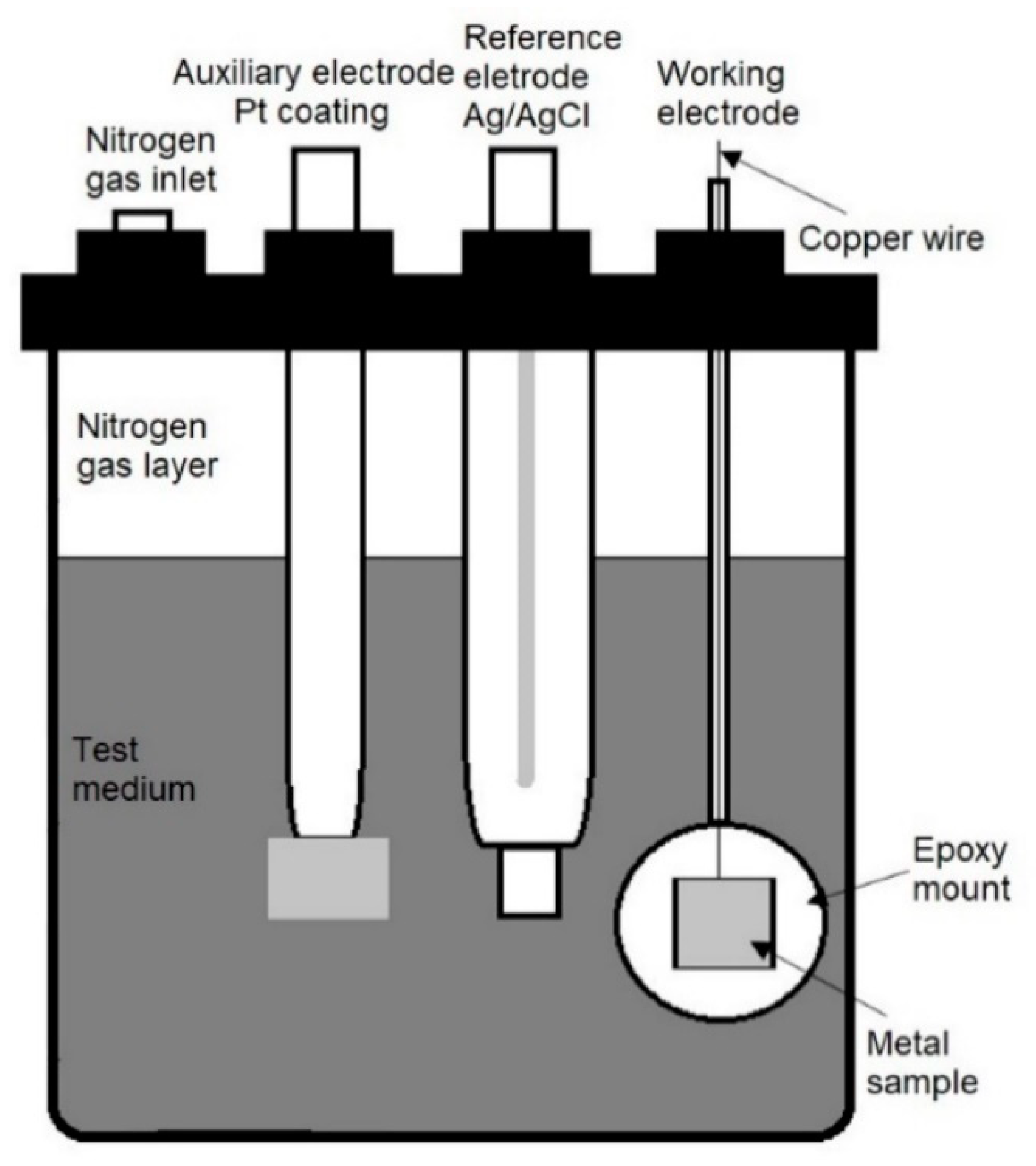




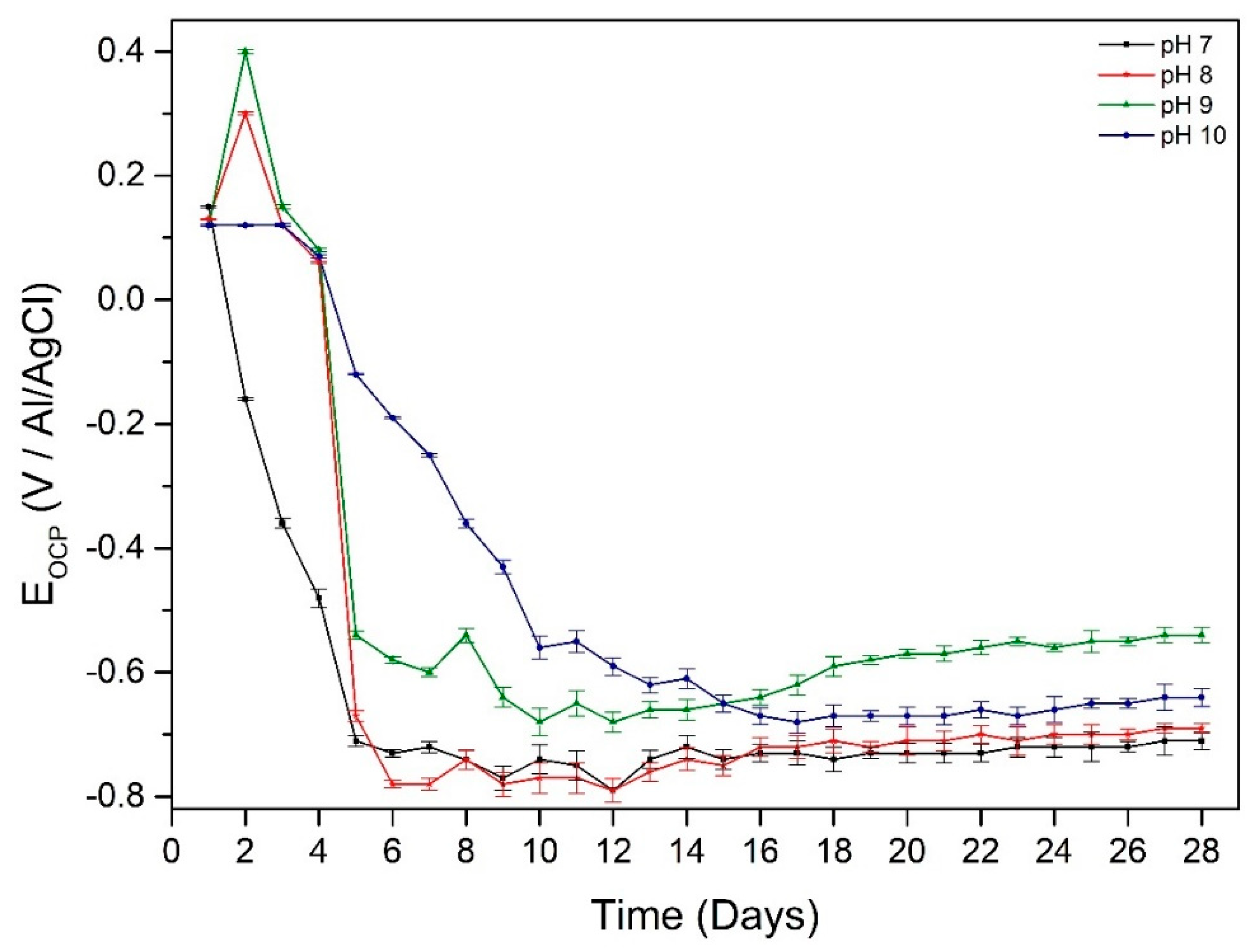

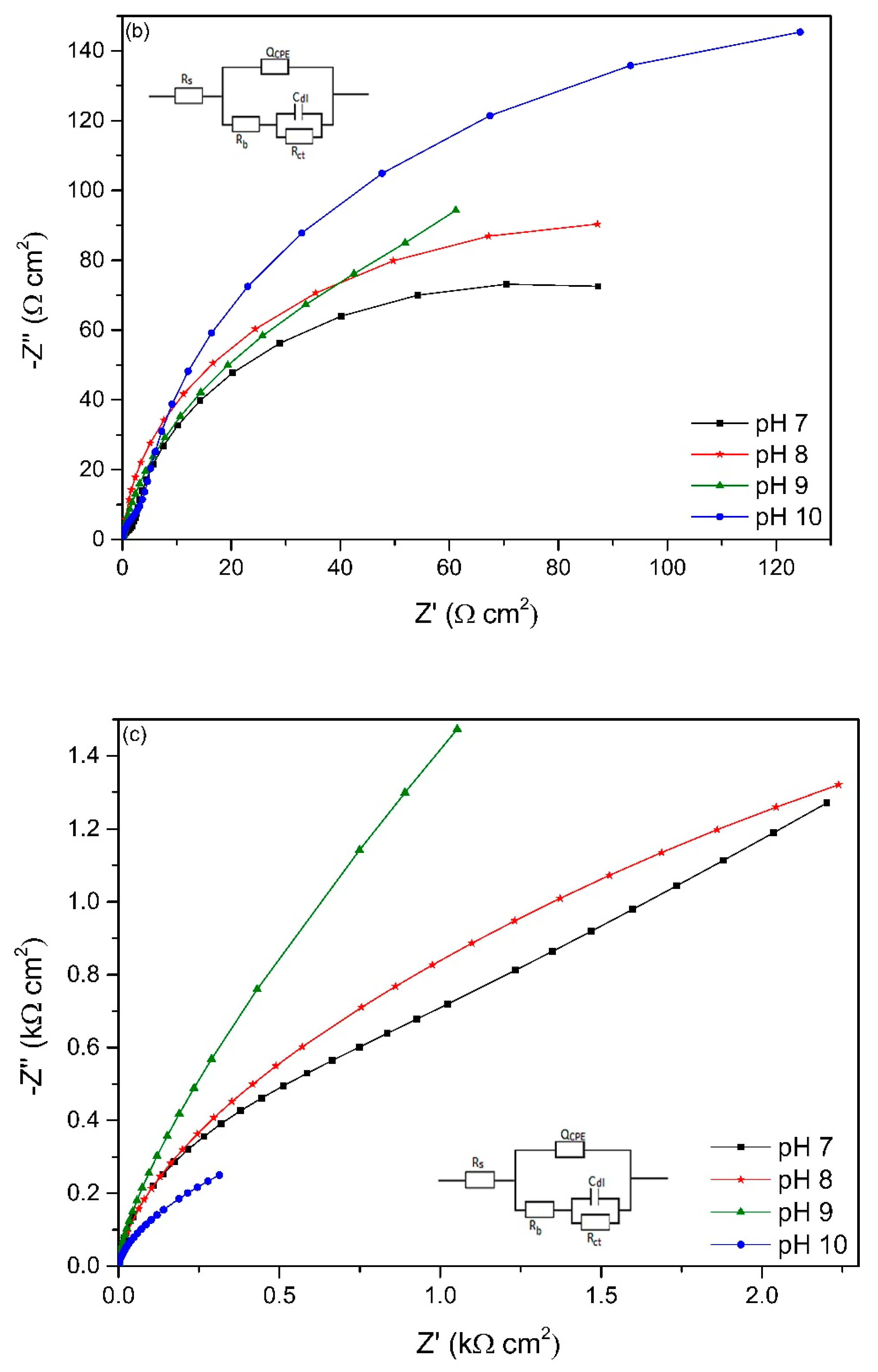
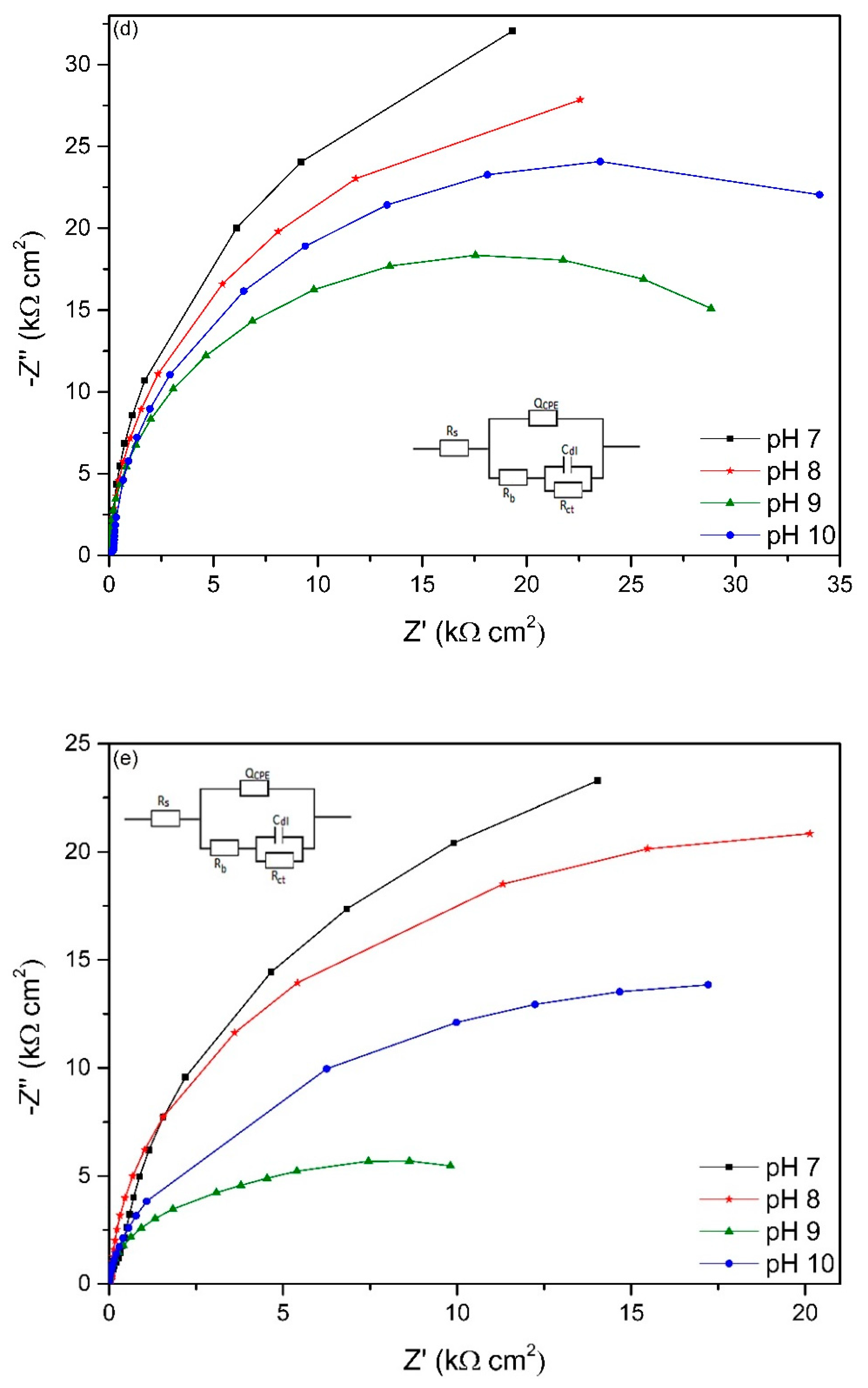
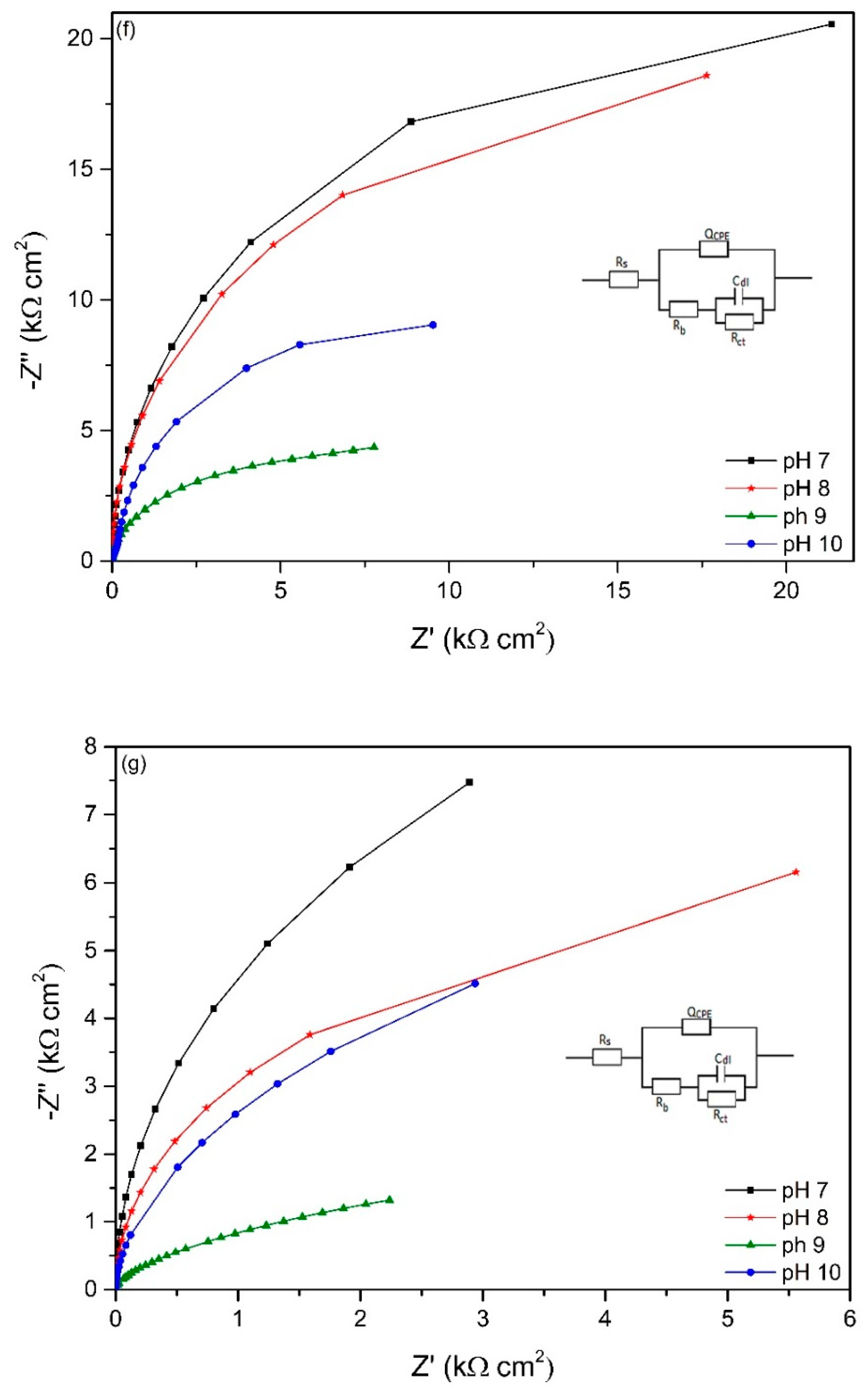


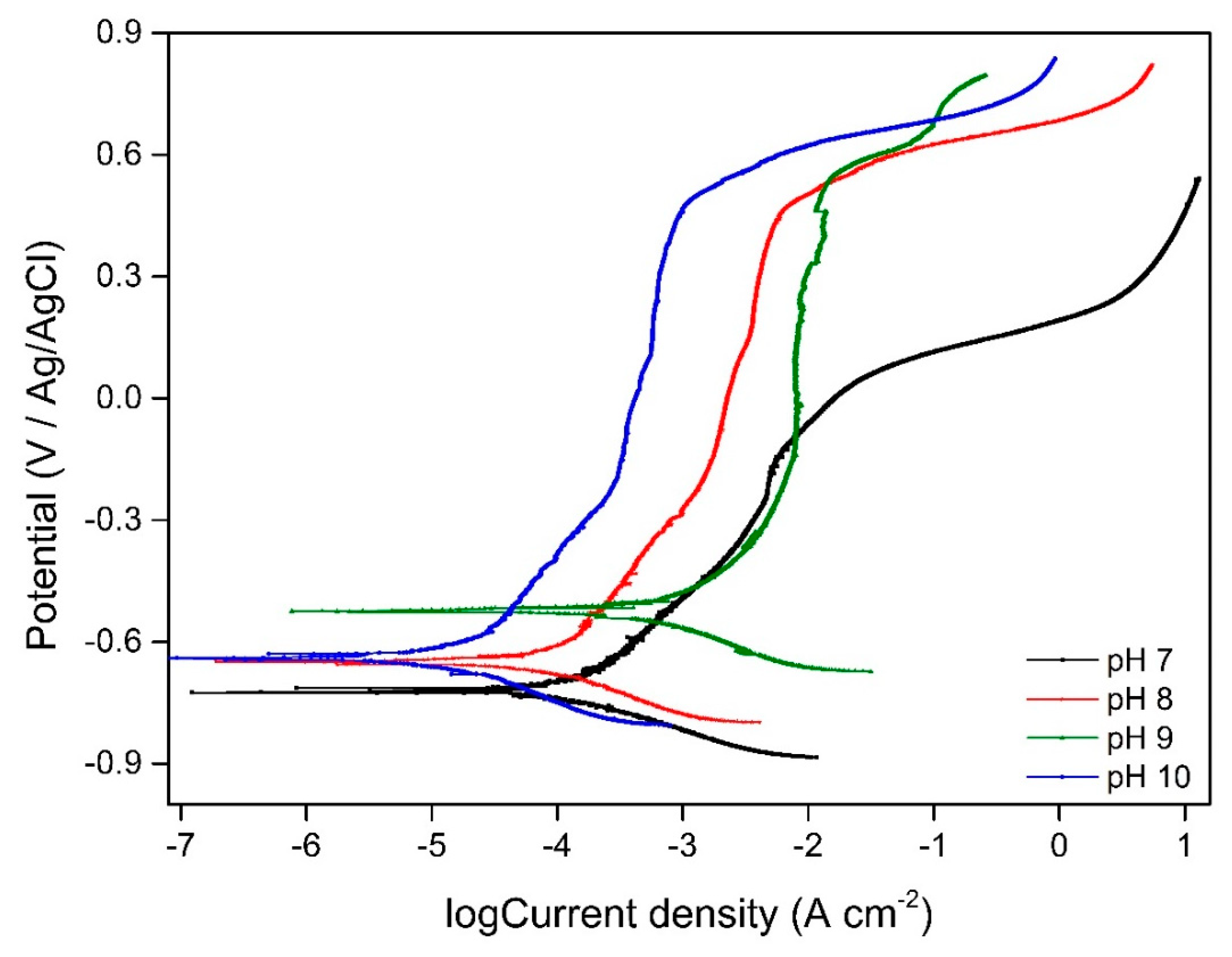
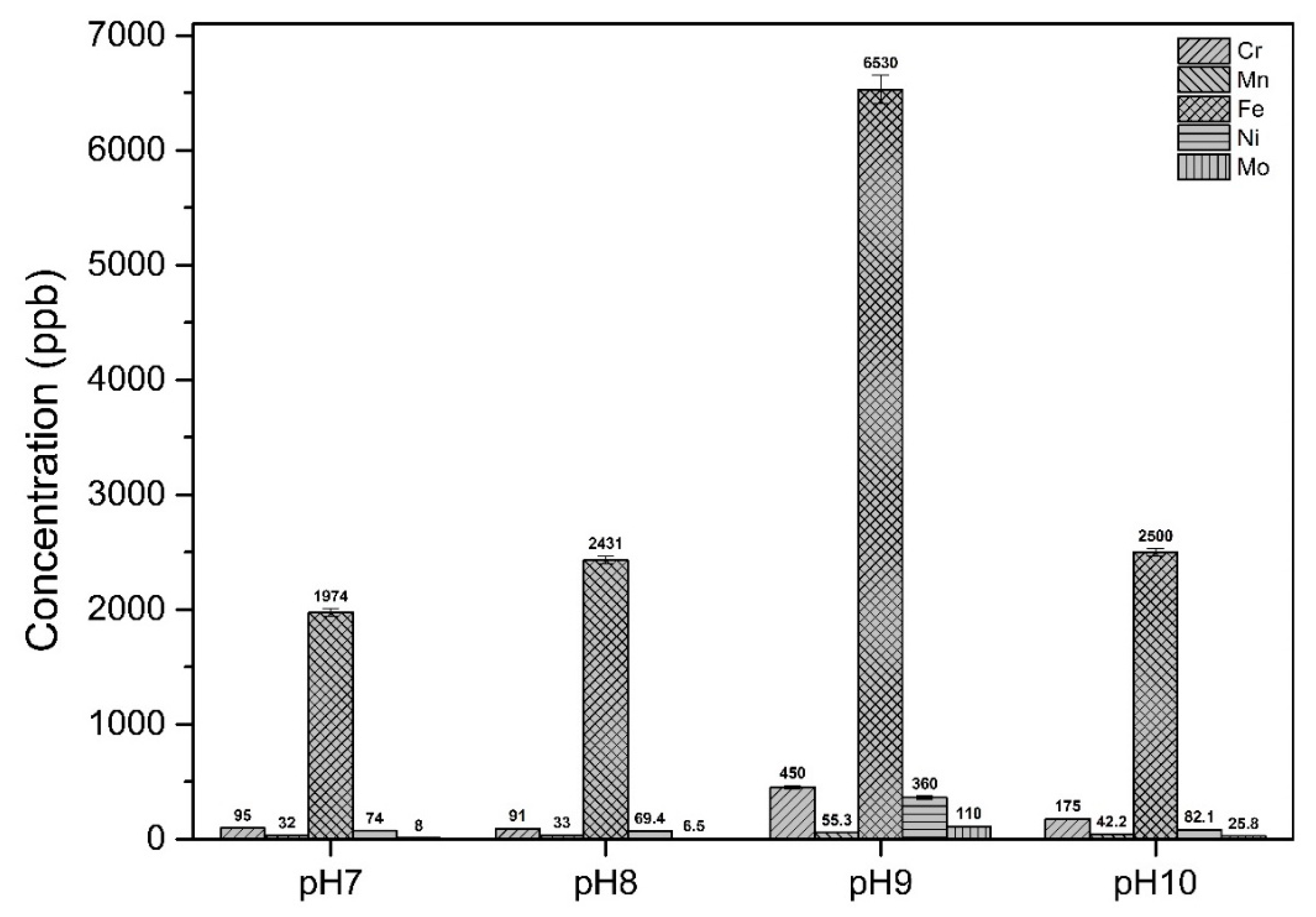
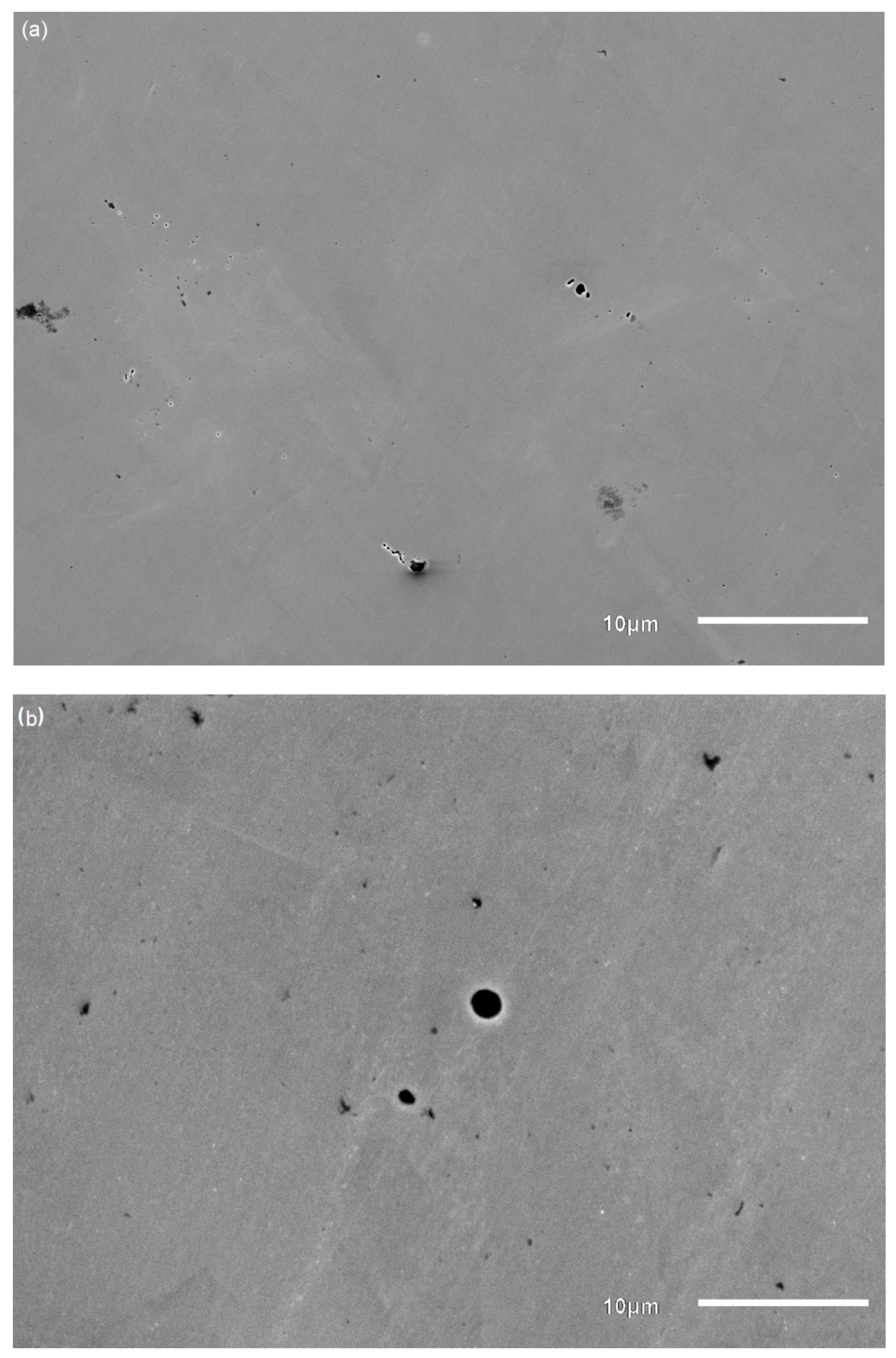
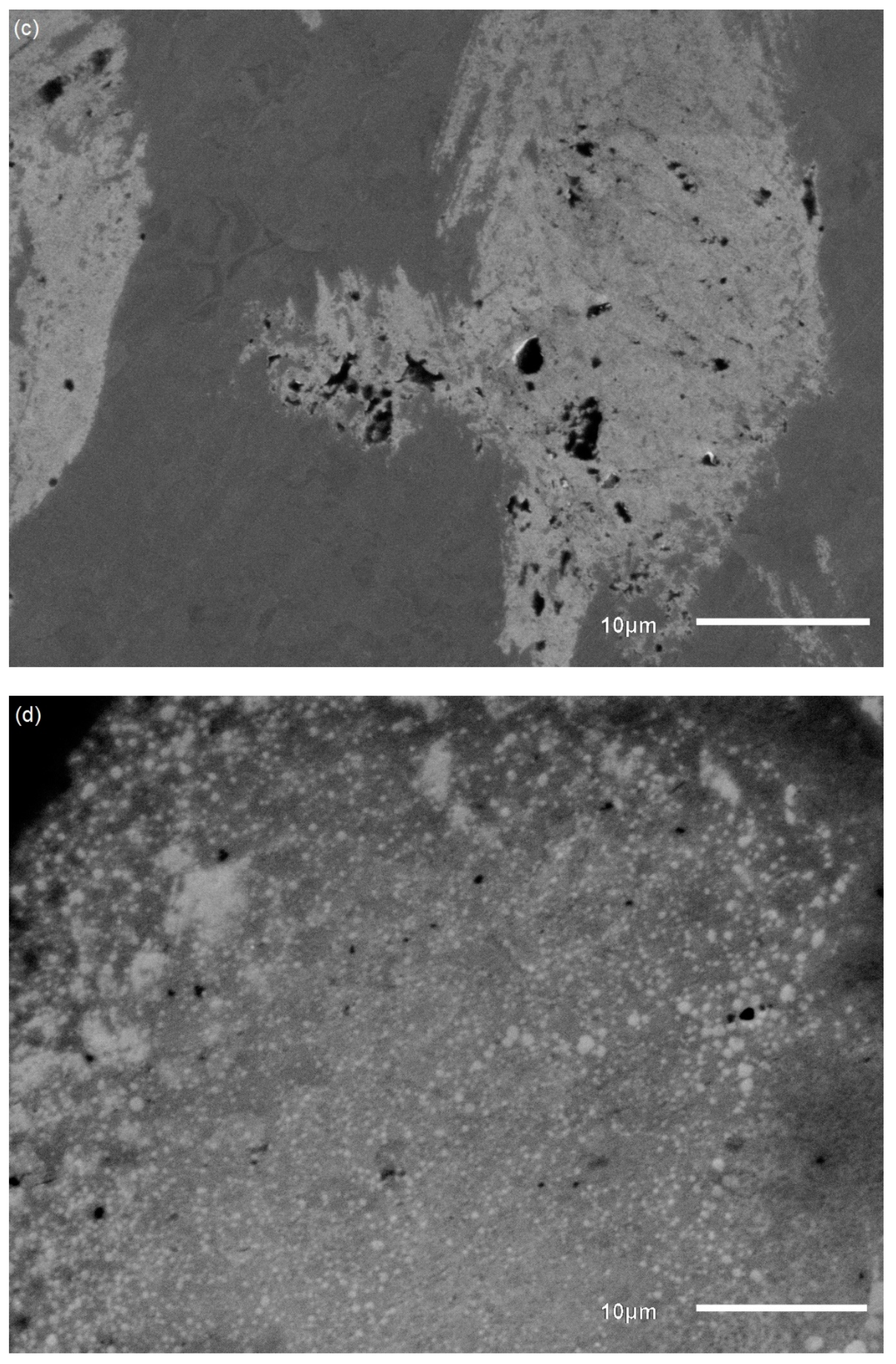
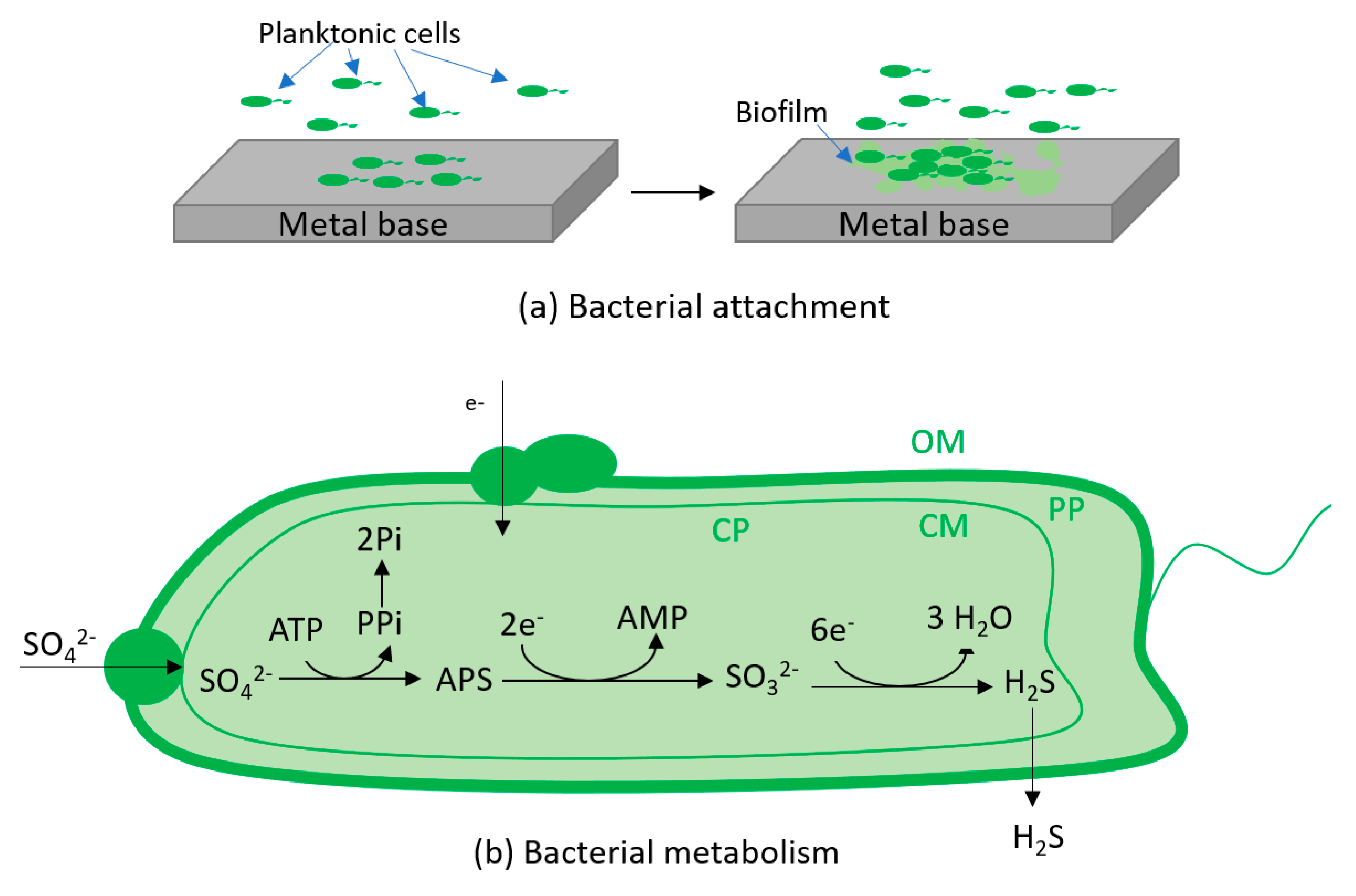
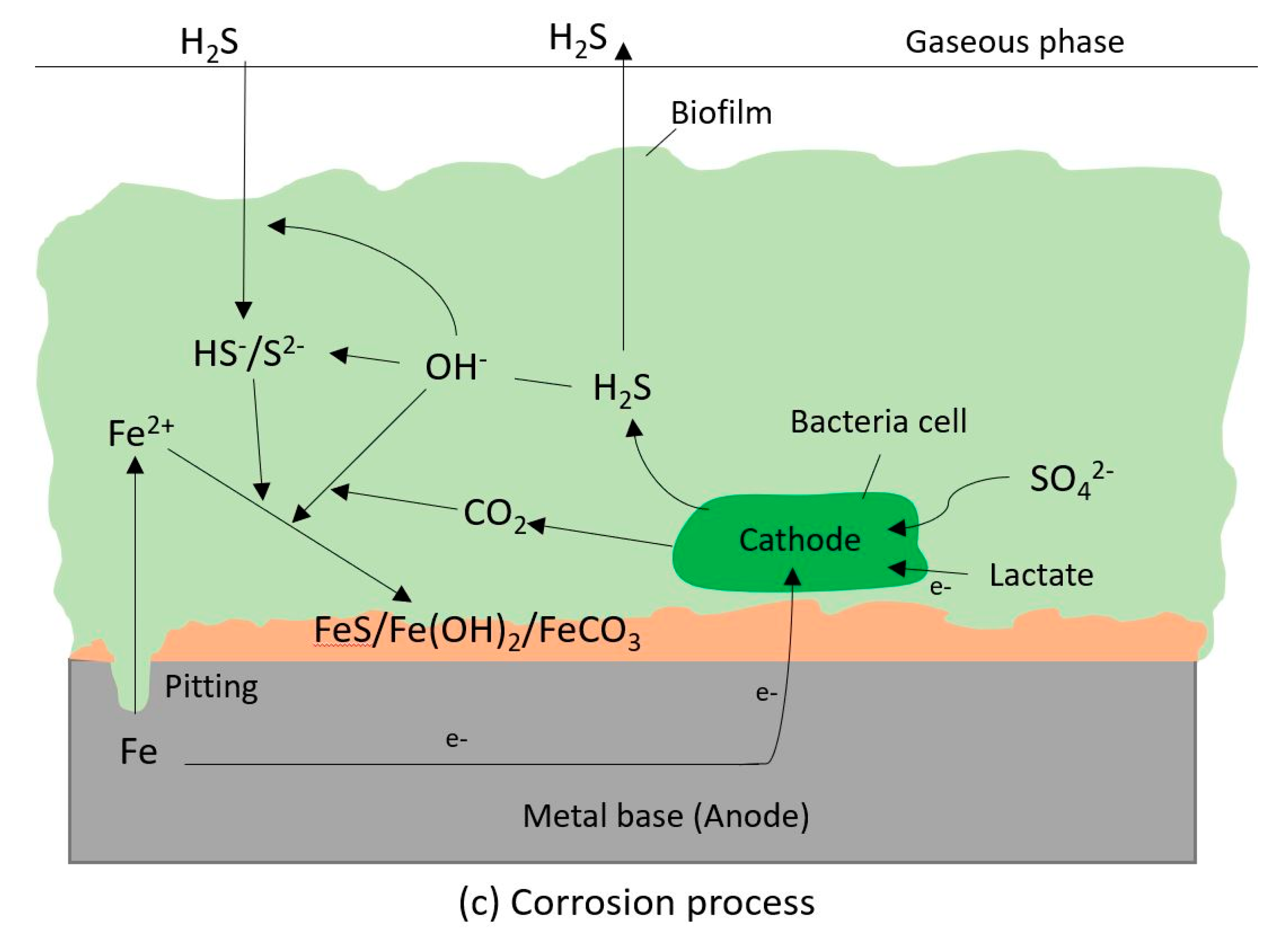
| Duplex Stainless Steel 2205 | Chemical Elements (%) | ||||||||
| Fe | Mn | S | V | Si | Cr | Ni | Cu | Mo | |
| 66.32 | 1.68 | 0.05 | 0.11 | 0.43 | 22.1 | 6.12 | 0.30 | 2.89 | |
| Icorr (mA·cm−2) | Ecorr (mV/Ag/AgCl) | |
|---|---|---|
| pH 7 | 0.166 | −707 |
| pH 8 | 0.228 | −685 |
| pH 9 | 0.867 | −542 |
| pH 10 | 0.282 | −641 |
| C | Si | S | Cr | Fe | Ni | |
|---|---|---|---|---|---|---|
| pH 7 | 3.49 | 0.41 | 2.11 | 23.34 | 65.1 | 5.55 |
| pH 8 | 2.18 | 0.52 | 2.77 | 23.21 | 65.29 | 6.03 |
| pH 9 | 2.1 | 0.34 | 3.82 | 23.06 | 65.68 | 5.46 |
| pH 10 | 2 | 0.39 | 3.11 | 23.39 | 65.01 | 6.1 |
© 2020 by the authors. Licensee MDPI, Basel, Switzerland. This article is an open access article distributed under the terms and conditions of the Creative Commons Attribution (CC BY) license (http://creativecommons.org/licenses/by/4.0/).
Share and Cite
Tran Thi Thuy, T.; Kannoorpatti, K.; Padovan, A.; Thennadil, S. Effect of Alkaline Artificial Seawater Environment on the Corrosion Behaviour of Duplex Stainless Steel 2205. Appl. Sci. 2020, 10, 5043. https://doi.org/10.3390/app10155043
Tran Thi Thuy T, Kannoorpatti K, Padovan A, Thennadil S. Effect of Alkaline Artificial Seawater Environment on the Corrosion Behaviour of Duplex Stainless Steel 2205. Applied Sciences. 2020; 10(15):5043. https://doi.org/10.3390/app10155043
Chicago/Turabian StyleTran Thi Thuy, Tien, Krishnan Kannoorpatti, Anna Padovan, and Suresh Thennadil. 2020. "Effect of Alkaline Artificial Seawater Environment on the Corrosion Behaviour of Duplex Stainless Steel 2205" Applied Sciences 10, no. 15: 5043. https://doi.org/10.3390/app10155043
APA StyleTran Thi Thuy, T., Kannoorpatti, K., Padovan, A., & Thennadil, S. (2020). Effect of Alkaline Artificial Seawater Environment on the Corrosion Behaviour of Duplex Stainless Steel 2205. Applied Sciences, 10(15), 5043. https://doi.org/10.3390/app10155043






